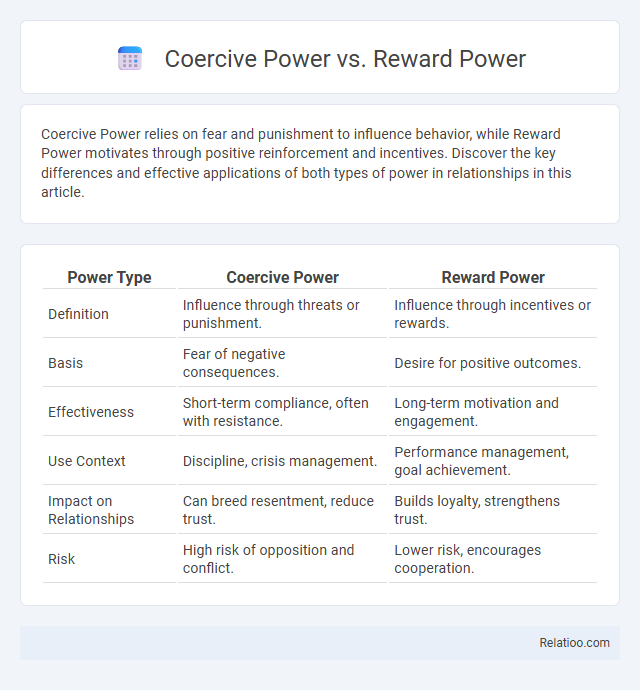Coercive Power relies on fear and punishment to influence behavior, while Reward Power motivates through positive reinforcement and incentives. Discover the key differences and effective applications of both types of power in relationships in this article.
Table of Comparison
| Power Type | Coercive Power | Reward Power |
|---|---|---|
| Definition | Influence through threats or punishment. | Influence through incentives or rewards. |
| Basis | Fear of negative consequences. | Desire for positive outcomes. |
| Effectiveness | Short-term compliance, often with resistance. | Long-term motivation and engagement. |
| Use Context | Discipline, crisis management. | Performance management, goal achievement. |
| Impact on Relationships | Can breed resentment, reduce trust. | Builds loyalty, strengthens trust. |
| Risk | High risk of opposition and conflict. | Lower risk, encourages cooperation. |
Understanding Coercive Power
Coercive power relies on fear and the threat of punishment to influence behavior, often resulting in compliance but potentially fostering resentment and reduced trust within teams. Unlike reward power, which motivates through positive incentives and recognition, coercive power can lead to a competitive dynamic characterized by resistance and decreased collaboration. Understanding coercive power's impact in organizational settings helps leaders balance authority with fairness to maintain employee engagement and minimize conflict.
Defining Reward Power
Reward power is the ability to influence others by offering valuable incentives or benefits, such as promotions, bonuses, or recognition, which motivate desired behaviors. In competitive dynamics, reward power often drives individuals to outperform rivals by pursuing tangible gains, whereas coercive power relies on fear of negative consequences. Understanding your reward power enables you to strategically encourage cooperation and enhance performance in competitive environments.
Key Differences Between Coercive and Reward Power
Coercive power relies on the ability to punish or threaten to enforce compliance, creating a climate of fear and potentially leading to resistance, while reward power motivates behavior through the promise of positive incentives, fostering cooperation and engagement. Your understanding of these key differences is crucial in navigating competitive dynamics, as coercive power can damage relationships and reduce morale, whereas reward power builds trust and encourages sustained performance. Effectively balancing these powers influences how influence is wielded within organizations and competitive settings.
Psychological Impact of Coercive Power
Coercive power induces fear and anxiety by threatening punishment, leading to decreased motivation and increased resistance among employees. Unlike reward power, which fosters positive reinforcement and engagement, coercive tactics often damage trust and morale, resulting in long-term psychological stress. In competitive dynamics, reliance on coercive power can escalate conflicts and reduce collaboration, undermining overall organizational cohesion.
Motivational Effects of Reward Power
Reward power uniquely motivates behavior by directly linking positive incentives to desired outcomes, enhancing Your drive to achieve specific goals. Unlike coercive power, which relies on fear or punishment, reward power fosters engagement and commitment through recognition and tangible benefits. In competitive dynamics, leveraging reward power can create a more constructive environment that encourages collaboration rather than conflict.
Situations Where Coercive Power Is Effective
Coercive power proves effective in high-stakes situations requiring immediate compliance, such as crisis management or enforcing security protocols where rapid obedience is critical to prevent harm. It is also useful in environments with clear hierarchical structures, like the military or emergency services, where the consequences of non-compliance must be swiftly enforced. Competitive dynamics intensify under coercive power as individuals or groups respond to threats or punishments, contrasting with reward power's emphasis on motivation through incentives.
When to Use Reward Power in Leadership
Reward power is most effective in leadership when motivating employees through positive reinforcement, such as bonuses, promotions, or recognition, to enhance performance and commitment. This approach works well in environments where tasks are repetitive or require high levels of compliance, fostering a culture of achievement and satisfaction. Leaders should use reward power to build intrinsic motivation and encourage goal attainment without relying on coercion or competition-driven stress.
Pros and Cons of Coercive Power
Coercive power leverages threats and punishments to enforce compliance, enabling quick control over behavior but often leading to fear, resentment, and reduced morale. While it can be effective for immediate issue resolution, overreliance on coercive tactics risks damaging organizational culture and long-term loyalty. In contrast, reward power motivates through incentives, fostering positive engagement, whereas competitive dynamics emphasize rivalry, which can either drive performance or create conflict.
Advantages and Limitations of Reward Power
Reward power leverages incentives to motivate behavior, enhancing employee satisfaction and driving performance through positive reinforcement; its advantages include fostering loyalty and encouraging goal attainment. However, limitations arise when rewards are perceived as unfair or insufficient, potentially reducing intrinsic motivation and creating dependency on external incentives. Your strategic use of reward power should balance tangible benefits with recognition to sustain engagement without fostering competition or coercion.
Choosing the Right Power Approach for Workplace Success
Coercive power, based on fear and punishment, often leads to resistance and low morale, making it less effective for long-term workplace success. Reward power leverages incentives and recognition to motivate employees, fostering engagement and productivity through positive reinforcement. Understanding the competitive dynamic between these power bases helps leaders choose a balanced approach, combining rewards with assertiveness to drive performance while maintaining a collaborative work environment.

Infographic: Coercive Power vs Reward Power
 relatioo.com
relatioo.com